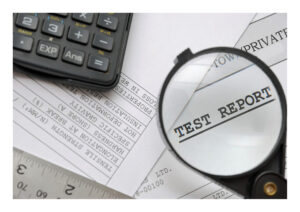Reporting for Impact

Lab reports are like bees.
According to the Earthwatch Institute, bees are the most important species on earth. These tiny creatures are responsible for ensuring pollination of up to 87 percent of leading food crops worldwide. Some authors estimate that if insect pollination were to fail, economic losses would be about 8 percent at most.
While this is a fun fact you could share at your next social event, it shows that it’s the little things that can have a significant impact.
Lab reports are not just something to be produced at the end of the lab process. They are actually important opportunities for communication and marketing. They are the little things that make a difference.
Whilst there are very specific requirements for test and calibration reports in ISO/IEC 17025 and ISO 15189, that’s just the beginning. We could give you the list, but that’s probably not that useful. Instead, we’ll explain how a good lab report helps to promote the lab, and how this can be achieved, all while complying with ISO/IEC 17025 or ISO 15189.
Enhancing your reputation
 A lab report doesn’t just state what you’ve done. A well-written, clear, and concise report can enhance the reputation of your lab to both customers and an accreditation body. It’s helpful to put yourself in the shoes of your customers in setting up the format for a report. And just because there is a list in a Standard doesn’t mean you have to present information in that order.
A lab report doesn’t just state what you’ve done. A well-written, clear, and concise report can enhance the reputation of your lab to both customers and an accreditation body. It’s helpful to put yourself in the shoes of your customers in setting up the format for a report. And just because there is a list in a Standard doesn’t mean you have to present information in that order.
Think about colour, font and consistency in branding. Ensure you have a cohesive and recognizable brand image. This helps to build trust and familiarity with your customers and potential customers.
What makes a great lab report?
Here’s a rundown on what to include in a great lab report.
Lab report headings
 Lab reports usually have several sections which should be easily identified. There’s no need to be creative here – clarity is the most important factor. Calling the document a Laboratory Report is a great start, and it ticks off that pesky requirement to have a title.
Lab reports usually have several sections which should be easily identified. There’s no need to be creative here – clarity is the most important factor. Calling the document a Laboratory Report is a great start, and it ticks off that pesky requirement to have a title.
The peripheral details
Think of this as a special letter writing exercise (remember those days?) where you had the details of the recipient, date, and your address at the top and your signature at the bottom. Reports are no different from a pre-formatted letter.
Your report will probably be on letterhead, so your company name, address, and logo are automatically generated.
The name and contact details of the client you’re carrying out the test or calibration for along with the date and unique identifier should be at the top of the report.
Specify the test or calibration site or location of testing or calibration on the report. Sorry, we don’t have a great reason for this, other than it’s in the Standard. Find a place in the report where this detail doesn’t detract from the main focus.
Page numbers are always helpful in case pages get lost or mixed up. Imagine reading a letter from your Mum about the funny exploits of your Dad. Halfway through the story, you start reading about the dog because the pages got scrambled. As well as losing the impact, it can be very confusing so pagination will ensure everyone gets the full story as it is meant to be told. Telling the client when they’ve reached the end of the report is also useful.
Finally, the name of the person authorising the report also needs to appear, typically at the end of the report.
Useful information
Just like any friendly letter, you need to give the recipient an idea of what you’ve been up to. Information on the who, what and when of the laboratory’s activities needs to be given to the client.
Reports must include information on the methods used for testing or calibration, details of what sample was tested or calibrated in terms that the customer and you can understand, and the dates of testing or calibration.
Depending on the type of test or calibration you’re carrying out, details of the samples should also be listed. For example, when the sample was collected, how the sample was received (e.g. plastic container, glass bottle); temperature on receipt; the appearance of the sample (e.g. cloudy liquid, viscous substance) and how it was treated on receipt (e.g. refrigerated). This will reassure your customers that their samples have been treated with care.
A section for sampling procedure could be helpful if you have anything to do with this activity or if it is important information to put the results into context. If a client requests a particular procedure which is outside your regular scope or process, that information could be listed here.
Results
This is probably one of the most important pieces of information you’re communicating to your customers, so it really needs to be clear. Test and calibration results are easier to read in table format. List the test or calibration, the method, the units of measurement, and the result. But again, if this information detracts from the main message of the results, then include this information elsewhere in the report.
Remember, if you are reporting calibration results, the uncertainty cannot be smaller than that stated on your scope of accreditation.
Remarks or comments
These can be included in a results table. For example, a summary of the overall results (e.g. fit for human consumption) can be included here. But be careful what you write.
Statements of fact are often perfectly fine. Opinions and other statements may not be, and we’re not saying this because you will have a grumpy NATA assessor to deal with. That barrier can be overcome! (If NATA insists it is really out of the question, it could be a restraint of trade…. and there are remedies for that!)
Check the coverage of any professional indemnity insurance policies held by your lab before you make these types of statements. Those comments on the interpretation of results may be where you can create additional value for your clients and showcase your people’s capabilities.
If you’re including some statements of compliance, like ‘pass’ or ‘fail’ of a material or product, then make sure you clearly state which specification you are comparing the results to and that you’re applying MU as agreed between you and the customer at the start.
Disclaimer
Again, this is probably something that’s automatically generated. Along with any legal requirements stated by your organisation, this should also mention that the report relates only to the sample or item received, calibrated, or tested.
What NATA requires
 If you’re an accredited facility in Australia, there are certain elements NATA requires your report to contain.
If you’re an accredited facility in Australia, there are certain elements NATA requires your report to contain.
You must include information from the standard you hold accreditation against e.g. ISO/IEC 17025. Different industries or programs have additional reporting requirements which are in the industry’s Appendix on the NATA website.
NATA accredited facilities can apply the NATA endorsement on reports for activities covered under their Scope of Accreditation. The endorsement is not just the NATA logo, it’s also the words that go along with it.
Labs should be careful to only apply this to reports covering tests or calibrations within their Scope. If there are some results of testing or calibration outside of the Scope, make sure you have a clear disclaimer in the report.
The logo (or emblem as it’s called) is available on the NATA website. However, before applying this do check the appropriate wording contained in the NATA Rules. All of the relevant information is in the NATA Accreditation Criteria and Guidance or NAC packages for your industry.
Amendments to lab reports
When an amended report needs to be issued, the change needs to be clearly identified. The reason for the change should also be reported.
The amended document or data transfer must also include words to the effect of “Amendment to Report number…”. If your lab does not use report numbers for uniquely identifying reports, then it may be using a report date. If that’s the case, the statement should say something like “Amendment to report dated…”.
Simplified Reports
If all this seems a bit much, you can negotiate with your customer to produce a simplified report. This might give you some valuable insights into what matters to your customers. You can also see how different ways of communicating key pieces of information can be beneficial to your customers and your lab.
We’ve got a lot to do in labs and a load of expectations to be met. As our only tangible product, a report is our opportunity to showcase to our customers and other parties who might have an interest in testing the great work we’ve been doing.
Taking a more customer-centric view can help make this valuable piece of communication even better for our customers and promote the lab’s expertise and value. Restrictions and conventions can be overcome with careful thought and conversation.
Want some advice on reporting to maximise your lab’s impact and position? We can review your report format and give you some ideas on what you can improve.
Just get in contact with Maree at maree@masmanagementsystems.com.au, or call 0411 540 709, for a conversation!
Remember, you don’t have to do this alone!
People who read this also enjoyed:




